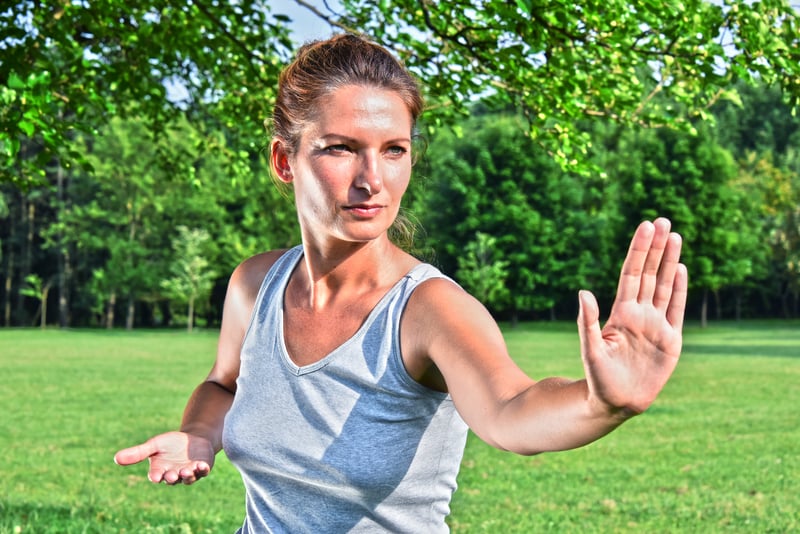Why You Should Try Tai Chi for Beginners (Fit + Fun)

Have you always wanted to try a martial arts form but weren’t sure which one to try? Well, we’ve got great news for you; you don’t have to do pushups on your knuckles or master a roundhouse kick to get the benefits of martial arts. Instead, you can start with a more gentle form of exercise by checking out this overview of tai chi for beginners. Read on to find out more about tai chi, how it can benefit you, and how you can get started now!
What is Tai Chi?
This ancient Chinese practice involves slow flowing movements, mindfulness, meditation, and proper breathing techniques. The name tai chi means “boundless fist” and is referred to by many as “meditation in motion.” It is a gentle form of exercise which incorporates mindfulness and is generally safe for all ages and abilities. While not designed specifically to burn extra calories or provide aerobic conditioning, tai chi nonetheless has many health benefits.
Types of Tai Chi
There are several different kinds of tai chi, and each type has its own focus. Here are three of the most common types:
- Yang style—this style is the most popular style and features large broad movements. This is typically the best style of tai chi for beginners.
- Chen style—a little more difficult than other styles, Chen-style tai chi incorporates faster and slower movements, mixing up the tempo.
- Wu style—this more advanced style, while not physically difficult, does involve a high level of mastery as the movements are extremely subtle, yet powerful.
Depending on the practitioner, various movements from different styles may be combined to form a unique style.
What Are the Benefits of Tai Chi for Beginners?
Of course, exercise has its benefits, and tai chi is no exception to this rule. This slow and gentle set of movements has benefits beyond those normally gleaned from simple exercise. Take a look at a few of these tai chi for beginners perks here:
- Better balance—learning to move your body and gaining strength through the practice of tai chi helps you gain better balance and improve agility.
- More self-confidence—increased ability to move and balance, as well as a focus on mind-body connection help develop more self-confidence, especially as you get older.
- Reduced stress—the deep breathing and mindfulness techniques you employ during tai chi help reduce stress and give you a sense of calm.
- Improved sleep—reduced tension and a calmer mind, both byproducts of tai chi, are helpful when it comes to getting restful sleep.
- Reduced depression—studies show exercise, especially gentle forms like tai chi, are helpful in boosting one’s mood.
- Meditation—the mind and body connection you are able to form while practicing tai chi is invaluable and assists with focus during
meditation. - Low impact—because there are no jarring movements, it’s a suitable form of exercise for almost everyone.

How to Do a Tai Chi Workout
It’s best to either have a teacher show you the movements or use a DVD or online video to learn tai chi. But, you can get a good start with some of the simple movements listed below.
Having a good warm-up is essential with any form of exercise you choose to engage in, and although tai chi is slow and gentle, a proper warm-up is still a good idea.
Warm Up Tai Chi Exercises for Beginners:
Waist Loosening Exercise—this warm-up exercise will help get the blood flowing and get your mind in the relaxed space it needs to be. Start by standing with your feet hip-width apart and your arms hanging at your sides. Gently move your hips from side to side, letting your arms hang loosely and follow along with the movement of your body. Next, put your head and neck into the movement, tilting your head to the left when your hips go left and to the right when your hips go right.
Knee Rolls—designed to loosen up your joints, stand with your legs about hip-width apart with your hands on your knees. Slowly rotate your knees in circles in both clockwise and counter-clockwise directions.
Some Poses/Movements to Try:
There are many movements to try as you learn tai chi, but for our purposes, here are a few beginner moves. You can also take a look at this link for some quick videos outlining some of the movements: Wiki: How to Do Tai Chi.
Energy Ball-this exercise involves “holding” an imaginary ball of energy between your hands. While pretending to hold a ball of energy in your hands, move your hands slightly apart and back again, while maintaining a firm “grip” on the ball of energy. Move your hands all around the ball and roll it around while keeping a slight pressure on the imaginary ball.
Single Whip—this movement is deceptively simple but can pack a lot of power. Standing with your feet hip-width apart, spread your arms out to your sides as wide as you can. With palms facing downward and thumbs touching fingers, move your right foot forward and place your right foot down as you bend the knee and slightly lunge forward. Your right arm will move forward at the same time as you open our your hand and bend it upwards (like you are telling someone to stop). With flowing movement, step back to the starting position, and repeat on the opposite side.
Forward Stretch—this movement is a staple and will help you gain flexibility in the hips. It is very similar to a forward lunge. While standing with your hands on your hips, step forward with your right leg, heel first, and bend at the knee until your leg forms a 90-degree angle. Pause and use your back leg to push you back up to the starting position and repeat with the other leg.
Ankle Tapping Exercise—this movement helps with balance and strength. While standing with your hands on your hips, feet hip-width apart, lift your right foot and place it slightly in front of you. Bend your left leg slightly to enable you to tap your right heel on the ground three times, followed by tapping your toes on the ground three times. Return to standing and repeat on the opposite side.
Closing Exercise:
Tai Chi Closing Posture—standing with your feet hip-width apart, bend your elbows, and bring your hands upward, palms up, until they are in front of your waist, elbows at your sides. Inhale, turn your palms downward and push the energy back toward the ground as you straighten your arms. Repeat three times.
Tai Chi for Beginners: A Recap
Although tai chi for beginners is a gentle exercise that uses energy for resistance, it’s a very beneficial workout. Just because it’s simple does not mean it’s easy. It’s definitely worth a try and the immense benefits will make you a big fan in no time.







